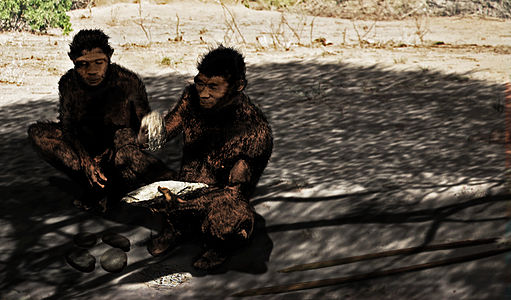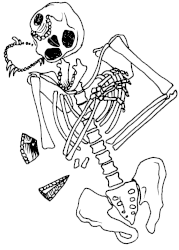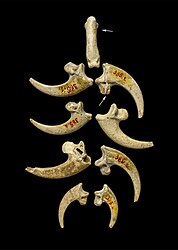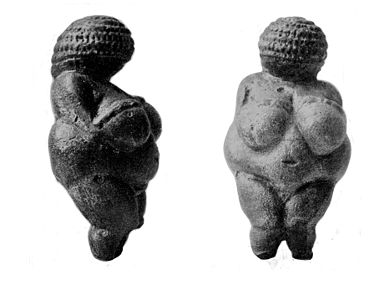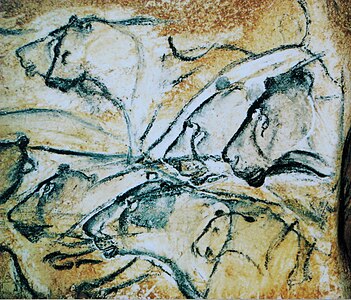Biological Anthropology/Unit 3: Human Evolution/MaterialCulture/OtherCulturalTraits
Contents
Homo erectus Culture
Homo erectus' diet was probably similar to its ancestors. This hominin probably scavenged for meat and foraged for plants, especially tubers. The evidence for hunting is complicated by the fact that most of the sites where there is a multitude of animal bone could be explained by the fact that animals and hominins were likely drawn to the same water sources, which could account for their presence. Cave sites like Zhoukoudian where the presence of animal bones such as elephants might be explained by human activity are marred by the presence of hyena bones. It is possible that the scavenging hyenas dragged the bones in to the cave.
The controlled use of fire is one of the cultural adaptations that changed human history. Fire allowed our early ancestors to inhabit glacial environments, extend working and socialization hours, assist with hunting, offer a measure of protection from wild animals and of course cook their food thereby killing parasites and bacteria and making food more digestible by removing toxins. Just when our ancestors began to use fire is hotly debated in paleoanthropology and archaeology. Some suggest that the earliest evidence of fire comes from Koobi Fora, Kenya where a 1.6 million year old "fireplace" was found; however, this interpretation of the evidence is hotly contended. Recently, evidence from Gesher Benot Ya'Aqov, Isreal suggests controlled use of fire occurred around 800,000 years ago (more on this below).
The movement of Homo erectus into cold environments suggests that they had some type of clothing. There is no material artifacts that support the inference; however, it would have been difficult for Homo erectus to survive in the northern latitude without some form of clothing.
There is some evidence that shelter construction took place approximately 400,000 years ago. Early contenders are the sites of Olorgesailie, Kenya, Kunture, Ethiopia, and Latamne, Syria. It is important to note that there are natural processes that could account for what appears to be the foundation of structures at all of these sites, therefore, we cannot definitively say there was intentional construction of shelters. The best evidence for shelter construction comes from Ariendorf I, Germany. In one of the levels at Ariendorf, large blocks of quartz and quartzite were found. The only way they could have gotten there is if people brought them. Combined with the scatter of bones and other artifacts around the blocks, researchers at the site are comfortable concluding that it is evidence of a structure.
Another debated possibility is the question of boating technology. Stone tools found on the Island of Flores in Indonesia suggest that hominins had boating capabilities. At the site of Mata Menge, twenty basalt artifacts were found. The artifacts include flakes and fractured pebbles. Using fission-track dating on animal fossils, researchers determined that the site was between 880,000-800,000 years old. At this time, Flores was separated from the south Asian mainland by a deep-water straight roughly 11 miles wide. The only way to get to the island would have been by some type of raft or boat. Unsurprisingly, the data is debated and archaeologists await further data to come to more definitive conclusions.
Until recently, aesthetic expression had been attributed solely to the purview of modern Homo sapiens. Research over the last couple of decades and a shift in how archaeologists think about aesthetics has led some to suggest that the first aesthetic expression belongs to Homo erectus. It has been proposed that the form of Acheulean tools, in particular the hand axe, is in and of itself a form of aesthetic expression. Ocher fragments were found at the Kapthurin site, Kenya, associated with artifacts and animal bones. These fragments appear to have been worn by grinding and rubbing. An incised elephant tibia at Bilingsleben, Germany and what might be a crude human figure from Berekhat Ram, Israel add to the debate about the first aesthetic expression.
Homo heidelbergensis Culture
While there is debate about whether H. erectus built shelters, there is evidence from Terra Amata, France, that H. heidelbergensis did build shelters. At Terra Amata researchers found post holes for multiple shelters. It is also generally accepted that H. heidelbergensis had the controlled use of fire by about 790kya. Researchers found fire-scorched debitage (debris from tool-making) and burned seeds and wood at Gesher Benot-Ya'aqov, Isreal.
H. heidelbergensis hunted big game, including horses, elephants, hippos, and wild deer. Three wooden spears were found in Schöningen, Germany dating to about 400kya. Found in association with stone tools and the remains of multiple butchered horses, the spears were 6.0 to 7.5 feet long and the construction suggests that they were used as javelins. The recovery of a rhino shoulder blade at Boxgrove, England, with a wound most likely caused by a spear suggests that the technology was in use by 500kya.
Sima de los Huesos, "pit of bones," in Atapuerca, Spain has one of the largest concentrations of hominin bodies ever found in one place. Archaeologists recovered the remains of at least twenty-eight individuals at the bottom of a 42-foot deep shaft. While there may be various reasons why there are so many bodies at Sima de los Huesos, including carnivore activity, accidental falling into the pit, and intentional disposal of the dead, a recent review of the fossil material by Nohemi Sala, a paleoanthropologist with the Joint Center for Evolution and Human Behavior, Institute of Health Carlos III in Madrid, reveals that at least one of the individuals was a murder victim (Zorich 2015). Sala's study shows that the earliest known murder victim died from a blow (or blows) to the forehead with a blunt object. The nature of the breaks suggests that they could not have been accidental or suicide. Sala's study also indicated little carnivore damage to the remains and little accidental types of breaks, undermining those hypotheses. Sala proposes that the individuals at Atapuerca were placed there intentionally, indicating "a capacity for both violence and compassion" (Zorich 2015).
At Bodo, Ethiopia, scientists found a H. heidelbergensis skull with cut marks similar to those found on animal bones, indicating that the skull had been defleshed. While the real purpose is unknown, researchers hypothesize that it may be related to cannibalism. The Bodo skull is the oldest evidence of a hominin (or hominins) deliberately processing the bone of another hominin (Jurmain et al, 2013).
Homo neanderthalensis Culture
Isotope studies of Neanderthal bones indicate that their diet was predominantly carnivorous. Butchered animal bones are found in abundance associated with Neanderthal fossils Reindeer and mammoths appear to have been dietary staples. Viewed in the context of the environment Neanderthals evolved in, it makes sense that they were meat eaters. Hunting was a dangerous activity for Neanderthals as they had to rely primarily on thrusting spears. Many Neanderthal fossils show evidence of trauma that could be associated with hunting. At sites such as Grotte de l'Hortus in France, and Krapina, Croatia, Neanderthal bones were found mixed with animal bones, all of which were broken and the marrow extracted. This suggests that Neanderthals cannibalized their own. Whether this was ritually done, accidentally done by later inhabitants, or a regular dietary practice is unknowable with the current data. Analysis of Neanderthal fossils from El Sidrón, Spain, support the claim that Neanderthals cannibalized their own (Thompson 2006).
Based on the remains found, researchers have been able to determine that many Neanderthals died before reaching adulthood. Few lived past the age of 30. Bones have Harris Lines, which means the long bones have cracks on the ends, and teeth show evidence of enamel hypoplasia (zones of thin tooth enamel). This evidence taken together tells us that Neanderthal children had poor nutrition, which may account for the short life span.
There is some debate on whether Neanderthals had language. A reconstruction of the Neanderthal vocal tract suggests that they communicated like human babies (Larsen 2014). However, a complete hyoid bone found in the Israel indicates that morphologically, Neanderthals would have had the same speech capabilities as modern humans. Coupled with the facts that the areas of the brain that are responsible for language, the cerebrum and Broca's area, evolved in early Homo and studies of scratch patterns on upper incisors and canines indicate brain laterality (which is related to handedness and how speech is controlled) indicate that Neanderthals could speak. Genetic evidence also supports the contention that Neanderthals speak as the FOXP2 gene, which is part of the genetic complex responsible for speech, is present (Larsen 2014). Some have suggested that in lieu of language, Neanderthals used music to communicate. A bird bone with four holes in it was found at a site in Slovenia and has been dated to 50,000 years, making it possibly the world's oldest flute. For a modern interpretation of what Neanderthal music might have sounded like, check out this BBC article.
Neanderthals exhibited other forms of symbolic behavior in addition to language. Pigments were used to on shells and animal bones that were then used as jewelry. Pigments may have been used to paint the body as well, but this is speculation. Burials are another form of symbolic behavior. It has been suggested that the presence of burials with grave goods indicates a belief in the afterlife. Others claim that the burials were of a more practical nature--it was a way to keep away scavengers and the odor of decaying bodies. Whatever, the reasons, there are several Neanderthal sites that show evidence of intentional burial: La Chappelle-aux-Saints, France, La Ferrassie, France, and Shanidar, Iraq, to name a few. In general, Neanderthal remains are found in a flexed position. A few burials have grave goods with them, e.g., stone and bone tools, ochre, and unmodified animals bones. At Shanidar, flower pollen was found in a burial, however, it could have easily blown into the grave. The burials, particularly those at Shanidar, allow us to look at the basic social structure of Neanderthals. One of the individuals at Shanidar was about 40-years-old when he died, a rather old age for a Neanderthal. This individual had several severe injuries that healed, including one that probably blinded him in one eye and another that would have inhibited his ability to find nourishment for himself, indicating that someone cared for him. The burials suggest that Neanderthals had at least some rudimentary knowledge of medicine.
Modern Homo sapiens Culture
In addition to the variety of tool industries, modern Homo sapiens had variable practices in the treatment of the dead. In addition to flexed burials, modern humans also buried their dead fully extended, often covering the bones in red ochre. This indicates that the bodies were de-fleshed, either naturally or by hand, prior to burial. Over time, burials become more and more elaborate with cremations, bundle burials, and elaborate burial cults, e.g., the ancient Egyptians. Burial goods became more common. These may have been as simple as a few stone tools to animal bones, minerals and eventually other human beings.
During the Upper Paleolithic, wolves were domesticated. Whether this was done intentionally by Homo sapiens is unclear; although many archaeologists think the wolf domesticated itself by trailing human camps and eating their garbage.
It is clear that modern Homo sapiens were excellent big game hunters. Sites abound with the remains of megafauna like mammoths. At the site of Dolni Vestonice in the Czech Republic, the remains of 800-900 mammoths were recovered. Excavations, ongoing since 1947, uncovered numerous structures constructed from mammoth bone, from windbreaks to roofed huts. Hearths, bird bones (flutes?), stone, bone and ivory tools, personal ornaments, a kiln and thousands of small fired clay figurines were found within the various structures. The variety of structures suggest that the site was occupied year-round.
Aesthetic expression in the form of portable and non-portable art becomes de rigor in the Upper Paleolithic. As mentioned above, personal adornment appears in the archaeological record. Necklaces, pendants and headbands made of shell, bone and ivory are found at numerous Upper Paleolithic sites. Carvings in bone, ivory and wood are evidenced in this period. Statues of clay also become common. The most well-known Upper Paleolithic carvings/clay moldings are the Venus figurines. These are small sculptures of human figures with exaggerated female characteristics--disproportional breasts, hips, thighs and buttocks. Other parts of the bodies, hands, feet, faces are not detailed. The first interpretation of these figurines was that they were fertility symbols representing Mother Earth. In 1996, LeRoy McDermott provided an alternate interpretation. He proposed that the Venus figurines were the first attempts at self-representation.
Non-portable art in the form of petroglyphs and cave paintings appear in the archaeological record around 36,000 years ago. Oval-shaped rock carvings (petroglyphs) appear at Wharton Hill, Australia. Cave paintings were found in Spain, Africa and Australia, although it is the cave paintings in France that are most well known. At Chauvet, France, over 300 paintings and engravings were found dating to 32,000-31,000 years. The paintings show us that the area was populated with animals that are now extinct in Europe: rhinoceros, lions, mammoths, and red panthers are a few example.
The most famous cave is Lascaux, France dated to 17,000 years. This cave was used extensively over time. Great effort went into creating these works of art. Many are found on the ceilings and in deep areas of the cave, where no natural light reached. Stone bowls were used as lamps to light these darks areas. The Upper Paleolithic artists used the natural formation of the cave to show movement of animals. The paintings were made with natural pigments made from minerals and cave water. Black, yellow, red and occasionally white were the colors that were created.
The subject of these murals is primarily animals. While some human figures are found, they are often simple stick-like figures or shown as an anthropomorphic, part-human, part-animal figure.
As with modern art, archaeologists have tried to interpret the themes of Upper Paleolithic art. The presence of animals and human figures with hunting weapons suggests that imparting hunting information was one of the purposes of the art. The number of seemingly pregnant animals leads to the conclusion that there was a concern with restocking food sources. Other possible explanations include imparting information about rituals, origin myths, proclamations, and feelings.
Around 17,000 years ago, one of the most coldest periods of the Pleistocene occurs. in the subsequent warming period, sea levels begin to rise and there is a worldwide extinction of the megafauna. This was most devastating in the Americas where modern humans had finally migrated. In response to environmental changes, modern humans began to settle for longer periods of time in semi-permanent and permanent villages. Around 12,000-11,000 years ago, the first domesticated plants and animals appear in the archaeological record. With the adoption of a sedentary lifestyle, human culture undergoes massive changes. To learn more about this topic, we suggest taking a class on world prehistory.
References
California Academy of Sciences [Internet]. 2010. Oldest evidence of stone tool use and meat-eating among human ancestors discovered: Lucy's species butchered meat. ScienceDaily (August 10). [cited 2010 Oct 16]. Available from: http://www.sciencedaily.com/releases/2010/08/100811135039.htm
Campbell BG, Loy JD. 2005. Humankind emerging, 8th edition. Needham Heights (MA): Allyn & Bacon.
Jurmain R, Kilgore L. Trevathan W. 2013 Essentials in physical anthropology. Belmont (CA): Wadsworth Cengage Learning.
Larsen, CS. 2014. Our origins: discovering physical anthropology. New York (NY): W. W. Norton & Company, Inc.
McDermott L. 1996. Self-representation in the Upper Paleolithic female figurines. Curr Anthropol 37(2): 227-275.
Price TD, Feinman G. 2010. Images of thepast, 6th edition. New York (NY): McGraw Hill.
Scarre, Chris. 2005. The human past: world prehistory & the development of human societies. London: Thames & Hudson Ltd.
Thieme H. 1997. Lower Paleolithic hunting spear from Germany. Nature [Internet] [cited 2015 Aug 21]; 385: 807-810. Available from: http://www.nature.com/nature/journal/v385/n6619/abs/385807a0.html
Thompson A. 2006. Neanderthals were cannibals, study confirms. LiveScience [Internet] [cited 2015 Aug 21]. Available from: http://www.livescience.com/1187-neanderthals-cannibals-study-confirms.html
Zorich Z. 2015. A place to hide the bodies. Archaeology [Internet] [cited 2015 Aug 21]; 68(5). Available from: http://offcampus.lib.washington.edu/login?url=http://search.ebscohost.com/login.aspx?direct=true&db=a9h&AN=108695657&site=ehost-live
